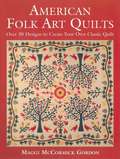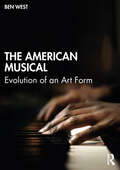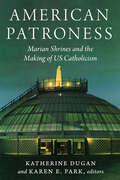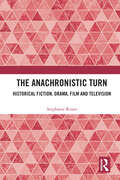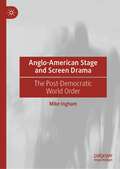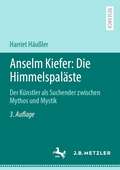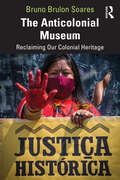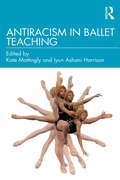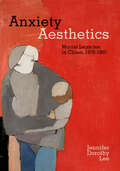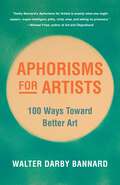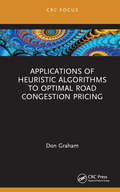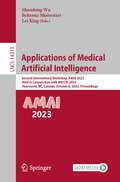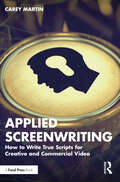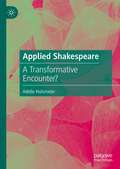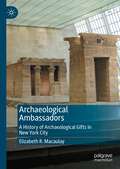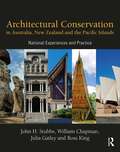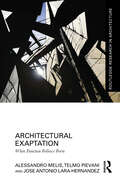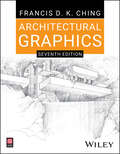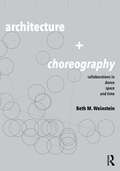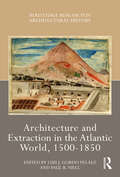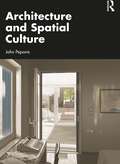- Table View
- List View
American Folk Art Quilts: Over 30 Designs to Create Your Own Classic Quilt
by Maggi McCormick GordonA Step-by-Step Guide to Creating Beautiful Quilts! Beautiful antique quilts and a workbook of patterns come together in this lavish photography book for quilters. The more than 30 featured quilts from the Wisconsin State Historical Society collection are displayed in period rooms at Old World Wisconsin, the Society's outdoor museum of German and Scandinavian farmhouses. Patterns and block layouts are provided for replicating each of the original quilts, and after seeing each of them in a true historical context, home sewers will be inspired to create their own versions.
The American Musical: Evolution of an Art Form
by Ben WestThe American Musical is a comprehensive history of an American art form. It delivers a detailed and definitive portrait of the American musical’s artistic evolution over the course of seven distinct, newly defined eras, with a unique perspective gleaned from research at more than twenty different archives across the United States.Individual in both its approach and coverage, The American Musical traces the form’s creative journey from its 19th century beginnings, through its 20th century maturation, and to the turn of the 21st century, shedding new light on a myriad of authors, directors, and craftspeople who worked on Broadway and beyond. This book actively addresses the form’s often overlooked female and African-American artists, provides an in-depth accounting of such outside influences as minstrelsy, vaudeville, nightclubs, and burlesque, and explores the dynamic relationship between the form and the consciousness of its country.The American Musical is a fascinating and insightful read for students, artists, and afficionados of the American musical, and anyone with an interest in this singular form of entertainment.
American Patroness: Marian Shrines and the Making of US Catholicism (Catholic Practice in the Americas)
by Adrienne Nock Ambrose Lloyd Barba James S. Bielo Katherine Dugan David J. Endres Kayla Harris Patrick J. Hayes Joseph Laycock Karen E. Park Terry Rey Stephen Selka Claire Vaughn Andrew Walker-CornettaA vital collection of interdisciplinary essays that illuminates the significance of Marian shrines and promises to teach scholars how to “read” them for decades to come.American Patroness: Marian Shrines and the Making of US Catholicism is a collection of twelve essays that examine the historical and contemporary roles of Marian shrines in US Catholicism. The essays in this collection use historical, ethnographic, and comparative methods to explore how Catholics have used Marian devotion to make an imprint on the physical and religious landscape of the United States. Using the dynamic malleability of Marian shrines as a starting place for studying US Catholicism, each chapter reconsiders the American religious landscape from the perspective of a single shrine to Mary and asks: What does this shrine reveal about US Catholicism and about American religion?Each of the contributors in American Patroness examines why and how Marian shrines persist in the twenty-first century and subsequently uses that examination to re-read contemporary US Catholicism. Because shrines are not neutral spaces—they reflect and shape the elastic yet strict boundaries of what counts as Catholic identity, and who controls prayer practices—the studies in this collection also shed light on the contested dynamics of these holy sites. American Patroness demonstrates that Marian shrines continue to be places where an American Catholic identity is continuously worked on, negotiations about power occur, and Marian relationships are fostered and nurtured in spaces that are simultaneously public and intimate.
The Anachronistic Turn: Historical Fiction, Drama, Film and Television
by Stephanie RussoThe Anachronistic Turn: Historical Fiction, Drama, Film and Television is the first study to investigate the ways in which the creative use of anachronism in historical fictions can allow us to rethink the relationship between past and present. Through an examination of literary, cinematic, and popular texts and practices, this book investigates how twenty-first century historical fictions use creative anachronisms as a way of understanding modern issues and anxieties. Drawing together a wide range of texts across all forms of historical fiction - novels, dramas, musicals, films and television - this book re-frames anachronism not as an error, but as a deliberate strategy that emphasises the fictionalising tendencies of all forms of historical writing. The book achieves this by exploring three core themes: the developing trends in the twenty-first century for creators of historical fiction to include deliberate anachronisms, such as contemporary references, music, and language; the ways in which the deliberate use of anachronism in historical fiction can allow us to rethink the relationship between past and present, and; the way that contemporary historical fiction uses anachronism to better understand modern issues and anxieties. This book will appeal to students and scholars of historical fiction, contemporary historical film and television studies, and historical theatre studies.
Anglo-American Stage and Screen Drama: The Post-Democratic World Order
by Mike InghamAnglo-American Stage and Screen Drama analyses and discusses the contemporary role of stage and screen drama as a critical forum for progressive thinking in an increasingly polarised geopolitical world. The book addresses the cultural politics of socially engaged 21st century stage plays and films, and makes the case for drama as a sociopolitical forum, in which the complex and contentious issues that confront society can be explored and debated. It conceives of Anglophone political drama as a significant intervention in today’s culture wars, representing the latter as a convenient distraction from the ongoing depredations of neoliberalism. In the main part of the book selected case-study plays and films from each of the first two decades illustrate drama’s capacity to influence critical debate on social justice issues. All of the case-study texts under discussion express a powerful aesthetics of resistance to right-wing ideology, and promote inclusive and enlightened values. This broader orientation underlines drama’s role as a channel for critical agency in today’s putative post-socialist, post-democratic climate.
Anime's Knowledge Cultures: Geek, Otaku, Zhai
by Jinying LiUnlocking the technosocial implications of global geek cultures Why has anime, a &“low-tech&” medium from last century, suddenly become the cultural &“new cool&” in the information age? Through the lens of anime and its transnational fandom, Jinying Li explores the meanings and logics of &“geekdom&” as one of the most significant sociocultural groups of our time. In Anime&’s Knowledge Cultures, Li shifts the center of global geography in knowledge culture from the computer boys in Silicon Valley to the anime fandom in East Asia. Drawing from film studies, animation studies, media theories, fan studies, and area studies, she provides broad cultural and theoretical explanations of anime&’s appeal to a new body of tech-savvy knowledge workers and consumers commonly known as geeks, otaku, or zhai. Examining the forms, techniques, and aesthetics of anime, as well as the organization, practices, and sensibilities of its fandom, Anime&’s Knowledge Cultures is at once a theorization of anime as a media environment as well as a historical and cultural study of transnational geekdom as a knowledge culture. Li analyzes anime culture beyond the national and subcultural frameworks of Japan or Japanese otaku, instead theorizing anime&’s transnational, transmedial network as the epitome of the postindustrial knowledge culture of global geekdom. By interrogating the connection between the anime boom and global geekdom, Li reshapes how we understand the meanings and significance of anime culture in relation to changing social and technological environments.
Anselm Kiefer: Der Künstler als Suchender zwischen Mythos und Mystik
by Harriet HäußlerDie Untersuchung der Himmelspaläste, mit denen Anselm Kiefer sein skulpturales Werk begründet, eröffnet einen vollkommen neuartigen Zugang zum Oeuvre des Künstlers. Aus der Betrachtung des Skulpturenzyklus´ konnte die Erkenntnis gewonnen werden, dass Kiefer keineswegs vorrangig als ein deutscher Künstler der Nachkriegszeit verstanden werden kann, der in seinen Werken vornehmlich Trauerarbeit und Vergangenheitsbewältigung leistet. Vielmehr ist er als ein bewusst selbstreflexiv arbeitender, künstlerischer Künstler zu bezeichnen, der sich bereits Jahre vor seinem Umzug nach Frankreich mit zahlreichen komplexen Themen, die nicht den nationalen bzw. den germanischen Themengebieten zuzurechnen sind, intensiv auseinandergesetzt hat.Anselm Kiefers Kunst verkörpert für Kiefer ein Reflexionsmedium, mit dessen Hilfe er sich selbst in der Welt situiert. Das Verhältnis zwischen Mikro- und Makrokosmos findet eine Entsprechung in Kiefers Verhältnis zu seinem eigenen Werk. Dieser als paradoxzu bezeichnende Bezug ist von Distanz und Nähe zugleich geprägt.
The Anticolonial Museum: Reclaiming Our Colonial Heritage
by Bruno Brulon SoaresThe Anticolonial Museum acknowledges some of the consequences of colonialism in the current work of museums. Looking at museum theory in a critical way, it proposes a radical revision of museums’ rhetoric on decolonisation, as well as their public image and practices. Bringing together a collection of reflections on decolonisation through the observation of museum performance and discourse, the author considers current practices in response to the social claims of marginalised groups and activists. Drawing from a genealogy of decolonial thinking in museology, Brulon Soares identifies the inherent paradoxes reflected in museum work. The book’s focus is not exclusively on the reality of colonised countries, nor on the context of former imperialist nations—instead, it raises anticolonial questions, finding common ground between the different actors involved in the museum: scholars, students, curators, practitioners, community members and Indigenous creators. One of the central aims of this book is to view the museum as a locus for multiple enunciations, thus identifying in museum practice the active possibility of reconnecting subjectivities and restoring material fluxes to effectively repair the bonds that have been frayed by colonialism and an expanding modernity. The Anticolonial Museum will be of great interest to researchers and students engaged in the study of decolonisation. It will also be essential for practitioners who wish to reconsider the impact of coloniality on their own position and everyday practice.
Antiracism in Ballet Teaching
by Kate Mattingly Iyun Ashani HarrisonThis new collection of essays and interviews assembles research on teaching methods, choreographic processes, and archival material that challenges systemic exclusions and provides practitioners with accessible steps to creating more equitable teaching environments, curricula, classes, and artistic settings. Antiracism in Ballet Teaching gives readers a wealth of options for addressing and dismantling racialized biases in ballet teaching, as well as in approaches to leadership and choreography. Chapters are organized into three sections - Identities, Pedagogies, and Futurities - that illuminate evolving approaches to choreographing and teaching ballet, shine light on artists, teachers, and dancers who are lesser known/less visible in a racialized canon, and amplify the importance of holistic practices that integrate ballet history with technique and choreography. Chapter authors include award-winning studio owners, as well as acclaimed choreographers, educators, and scholars. The collection ends with interviews featuring ballet company directors (Robert Garland and Alonzo King), world-renowned scholars (Clare Croft, Thomas F. DeFrantz, Brenda Dixon Gottschild), sought-after choreographers (Jennifer Archibald and Claudia Schreier), and beloved educators (Keesha Beckford, Tai Jimenez, and Endalyn Taylor). This is an essential resource for anyone teaching or learning to teach ballet in the Twenty First Century.
Anxiety Aesthetics: Maoist Legacies in China, 1978–1985
by Jennifer Dorothy LeeAnxiety Aesthetics is the first book to consider a prehistory of contemporaneity in China through the emergent creative practices in the aftermath of the Mao era. Arguing that socialist residues underwrite contemporary Chinese art, complicating its theorization through Maoism, Jennifer Dorothy Lee traces a selection of historical events and controversies in late 1970s and early 1980s Beijing. Lee offers a fresh critical frame for doing symptomatic readings of protest ephemera and artistic interventions in the Beijing Spring social movement of 1978–80, while exploring the rhetoric of heated debates waged in institutional contexts prior to the '85 New Wave. Lee demonstrates how socialist aesthetic theories and structures continued to shape young artists' engagement with both space and selfhood and occupied the minds of figures looking to reform the nation. In magnifying this fleeting moment, Lee provides a new historical foundation for the unprecedented global exposure of contemporary Chinese art today.
Aphorisms for Artists: 100 Ways Toward Better Art
by Walter Darby BannardA Volume of Timeless Wisdom for Artists to Consult Like an Oracle Why do young artists struggle to find their voices? Walter Darby Bannard, a renowned teacher, critic, and internationally exhibited painter, contemplated that question for more than two decades. At the urging of one of his former students, Bannard set down his thoughts in a short book, Aphorisms for Artists: 100 Ways Toward Better Art. It is at once a volume of practical art-making wisdom and an engaging piece of personal philosophy, both wry and readable. Open to any page, and you'll find a memorable gem of wisdom, followed by a brief expansion by Bannard that adds more insight. It is a necessary reference to keep on hand in the studio, and a perfect gift for the aspiring artist to read and re-read, and to consult at times of artistic troubles.
Applications of Heuristic Algorithms to Optimal Road Congestion Pricing
by Don GrahamRoad congestion imposes major financial, social, and environmental costs. One solution is the operation of high-occupancy toll (HOT) lanes. This book outlines a method for dynamic pricing for HOT lanes based on non-linear programming (NLP) techniques, finite difference stochastic approximation, genetic algorithms, and simulated annealing stochastic algorithms, working within a cell transmission framework. The result is a solution for optimal flow and optimal toll to minimize total travel time and reduce congestion. ANOVA results are presented which show differences in the performance of the NLP algorithms in solving this problem and reducing travel time, and econometric forecasting methods utilizing vector autoregressive techniques are shown to successfully forecast demand. The book compares different optimization approaches It presents case studies from around the world, such as the I-95 Express HOT Lane in Miami, USA Applications of Heuristic Algorithms to Optimal Road Congestion Pricing is ideal for transportation practitioners and researchers.
Applications of Medical Artificial Intelligence: Second International Workshop, AMAI 2023, Held in Conjunction with MICCAI 2023, Vancouver, BC, Canada, October 8, 2023, Proceedings (Lecture Notes in Computer Science #14313)
by Shandong Wu Behrouz Shabestari Lei XingThis book constitutes the refereed proceedings of the first International Workshop on Applications of Medical Artificial Intelligence, AMAI 2023, held in conjunction with MICCAI 2023, in Vancouver, Canada in October 2023. The book includes 17 papers which were carefully reviewed and selected from 26 full-length submissions.The AMAI 2023 workshop created a forum to bring together researchers, clinicians, domain experts, AI practitioners, industry representatives, and students to investigate and discuss various challenges and opportunities related to applications of medical AI.
Applied Computer Vision and Soft Computing with Interpretable AI
by Swati V. Shinde Darshan V. Medhane Oscar CastilloThis reference text presents the knowledge base of computer vision and soft computing techniques with their applications for sustainable developments. Features: Covers a variety of deep learning architectures useful for computer vision tasks Demonstrates the use of different soft computing techniques and their applications for different computer vision tasks Highlights the unified strengths of hybrid techniques based on deep learning and soft computing taken together that give the interpretable, adaptive, and optimized solution to a given problem Addresses the different issues and further research opportunities in computer vision and soft computing Describes all the concepts with practical examples and case studies with appropriate performance measures that validate the applicability of the respective technique to a certain domain Considers recent real word problems and the prospective solutions to these problems This book will be useful to researchers, students, faculty, and industry personnel who are eager to explore the power of deep learning and soft computing for different computer vision tasks.
Applied Screenwriting: How to Write True Scripts for Creative and Commercial Video
by Carey MartinPutting a vision on the page for creative and commercial video is harder than it seems, but author Carey Martin explains how to bring these tools to bear in the “work for hire” environment. Whilst other texts focus on writing the next award winner, this can be out of reach both logistically and financially for many. Instead, readers will learn how to write what they want the eyes of the audience to see and the ears of the audience to hear, in such a way that the Producer and Director can read the creative blueprint and bring that vision to life. The text will walk readers through a focused and practical consideration of the camera, the edit, and the sound design, in addition to a straightforward application of basic story principles. By understanding writing for video as more than creating a recorded play, readers will become more effective screenwriters and, should they wish, Producers and Directors as well. This book is ideal for students of screenwriting and those writing scripts for message-driven video for corporate, nonprofit, and commercial production.
Applied Shakespeare: A Transformative Encounter?
by Adelle HulsmeierThis book speaks to those interested in where and why Shakespeare’s work is used to capture the transformative intentions of different areas of Applied Theatre practice (Prison, Disability, Therapy), representing a foundational study which considers subsequent histories and potential challenges when engaging with Shakespeare’s work. This is grounded in a case study analysis of three salient British Theatre Companies: The Education Shakespeare Company (prison), the Blue Apple Theatre Company (Disability), and the Combat Veteran Players (therapy).
Appreciation Post: Towards an Art History of Instagram
by Tara WardWhat does an art history of Instagram look like? Appreciation Post reveals how Instagram shifts long-established ways of interacting with images. Tara Ward argues Instagram is a structure of the visual, which includes not just the process of looking, but what can be seen and by whom. She examines features of Instagram use, including the effect of scrolling through images on a phone, the skill involved in taking an "Instagram-worthy" picture, and the desires created by following influencers, to explain how the constraints imposed by Instagram limit the selves that can be displayed on it. The proliferation of technical knowledge, especially among younger women, revitalizes on Instagram the myth of the masculine genius and a corresponding reinvigoration of a masculine audience for art. Ward prompts scholars of art history, gender studies, and media studies to attend to Instagram as a site of visual expression and social consequence. Through its insightful comparative analysis and acute close reading, Appreciation Post argues for art history’s value in understanding the contemporary world and the visual nature of identity today.
Archaeological Ambassadors: A History of Archaeological Gifts in New York City
by Elizabeth R. MacaulayThis book investigates why nations with rich archaeological pasts like Egypt, Greece, and Jordan gave important antiquities—often unique, rare, and highly valued monuments—to New York City, New York Institutions, and the United States from 1879 to 1965. In addition to analyzing the givers’ motivations, the author examines why New Yorkers and Americans coveted such objects. The book argues that these gifted antiquities function as archaeological ambassadors and that the objects given were instruments of cultural diplomacy. These gifts sought to advance the goals of Egypt, Greece, and Jordan—all states that had rich cultural and archaeological heritages—with the United States, once an ascendent nation and then a global superpower, to strengthen cultural, economic, and political relations.
Architectural Conservation in Australia, New Zealand and the Pacific Islands: National Experiences and Practice
by John H. Stubbs William Chapman Julia Gatley Ross KingThe fourth in a series that documents architectural conservation in different parts of the world, Architectural Conservation in Australia, New Zealand and the Pacific Islands: National Experiences and Practice addresses cultural heritage protection in a region which comprises one third of the Earth’s surface. In response to local needs, Australia, New Zealand and the Pacific Islands have developed some of the most important and influential techniques, legislation, doctrine and theories in cultural heritage management in the world. The evolution of the heritage protection ethos and contemporary architectural conservation practices in Australia and Oceania are discussed on a national and regional basis using ample illustrations and examples. Accomplishments in architectural conservation are discussed in their national and international contexts, with an emphasis on original developments (solutions) and contributions made to the overall field. Enriched with essays contributed from fifty-nine specialists and thought leaders in the field, this book contains an extraordinary breadth and depth of research and synthesis on the why’s and how’s of cultural heritage conservation. Its holistic approach provides an essential resource and reference for students, academics, researchers, policy makers, practitioners and all who are interested in conserving the built environment.
Architectural Exaptation: When Function Follows Form (Routledge Research in Architecture)
by Alessandro Melis Telmo Pievani Jose Antonio Lara-HernandezArchitectural Exaptation: When Function Follows Form focuses on the significance and the originality of the study of exaptation. It presents exaptation as an opportunity to extend architectural design towards more sustainable approaches aimed at enforcing urban resilience.The use of exaptation’s definition in architecture supports the heuristic value of cross-disciplinary studies on biology and architecture, which seem even more relevant in times of global environmental crises. This book aims to make a critique of the pre-existing and extensive paternalistic literature. Exaptation will be described as a functional shift of a structure that already had a prior, but different, function. In architecture, a functional shift of a structure that already had a function may apply to forms of decorative elements embedded in architectural components, and to both change of function of tectonic elements and the change of use of an architectural space. The book is illustrated with examples from around the globe, including China, Italy, Mexico, New Zealand, the USA and the UK, and looks at different civilizations and diverse historical periods, ranging from the urban to the architectural scale. Such examples highlight the potential and latent human creative capacity to change the use and functions, something that cities and buildings could consider when facing disturbances. Exaptation is shown as an alternative narrative to the simplifications of evolutionary puritanism. It also offers an innovative perspective and presents an opportunity to re-think the manner in which we design and redesign our cities.This book will be of interest to architecture, planning, urban design and biology researchers and students.
Architectural Graphics
by Francis D. ChingARCHITECTURAL GRAPHICS Architectural Graphics is the classic bestselling reference by one of the leading global authorities on architectural design drawing, Francis D. K. Ching. This seventh edition offers a comprehensive introduction to graphic tools and drafting conventions to translate architectural ideas into effective visual presentations, using hundreds of the author’s distinctive drawings to illustrate each topic. Updated throughout, this revised edition presents new beginner-friendly guidance for perspectives and sketching, updates on hand rendering and visual communication, and additional material on transitioning from analog to digital with CAD and digital drawing tools. Architectural graphics are key tools for conveying design through representation on paper or on screen. This book is the ultimate guide to mastering the skill and applying your talent to create more effective design communication, teaching how to: Understand multiview, paraline, and perspective drawing Master interior sections using a variety of techniques Render tonal value, enhance depth, and convey illumination Develop professional-quality layouts for presentations Architectural graphics both inform the design process and serve as the means by which a design is interpreted and built. Complete mastery of the tools and conventions is essential to the successful outcome of any project, and mistakes can cause confusion, time delays, increased costs, and possible catastrophe. Architectural Graphics is the comprehensive guide to professional architectural drawing, with insight from a leading authority.
Architecture against Democracy: Histories of the Nationalist International
by Reinhold Martin Claire ZimmermanExamining architecture&’s foundational role in the repression of democracy Reinhold Martin and Claire Zimmerman bring together essays from an array of scholars exploring the troubled relationship between architecture and antidemocratic politics. Comprising detailed case studies throughout the world spanning from the early nineteenth century to the present, Architecture against Democracy analyzes crucial occasions when the built environment has been harnessed as an instrument of authoritarian power. Alongside chapters focusing on paradigmatic episodes from twentieth-century German and Italian fascism, the contributors examine historic and contemporary events and subjects that are organized thematically, including the founding of the Smithsonian Institution, Ellis Island infrastructure, the aftermath of the Paris Commune, Cold War West Germany and Iraq, Frank Lloyd Wright&’s domestic architecture, and Istanbul&’s Taksim Square. Through the range and depth of these accounts, Architecture against Democracy presents a selective overview of antidemocratic processes as they unfold in the built environment throughout Western modernity, offering an architectural history of the recent &“nationalist international.&” As new forms of nationalism and authoritarian rule proliferate across the globe, this timely collection offers fresh understandings of the role of architecture in the opposition to democracy. Contributors: Esra Akcan, Cornell U; Can Bilsel, U of San Diego; José H. Bortoluci, Getulio Vargas Foundation; Charles L. Davis II, U of Texas at Austin; Laura diZerega; Eve Duffy, Duke U; María González Pendás, Cornell U; Paul B. Jaskot, Duke U; Ana María León, Harvard U; Ruth W. Lo, Hamilton College; Peter Minosh, Northeastern U; Itohan Osayimwese, Brown U; Kishwar Rizvi, Yale U; Naomi Vaughan; Nader Vossoughian, New York Institute of Technology and Columbia U; Mabel O. Wilson, Columbia U.
Architecture and Choreography: Collaborations in Dance, Space and Time
by Beth WeinsteinArchitecture and Choreography: Collaborations in Dance, Space and Time examines the field of archi-choreographic experiments—unique interdisciplinary encounters and performed events generated through collaborations between architects and choreographers.Forty case studies spanning four decades give evidence of the range of motivations for embarking on these creative endeavors and diverse conceptual underpinnings, generative methods, objects of inquiry, and outcomes. Architecture and Choreography builds histories and theories through which to examine these works, the contexts within, and processes through which the works emerged, and the critical questions they raise about ways to work together, sites and citations, ethics and equity, control and agency. Three themes frame pairs of chapters. The first addresses disciplinarity through works that critically reflect upon their discipline’s tools, techniques, and conventions juxtaposed against projects that cite or use other art forms and cultural phenomena as source material. The second interrogates space and the role of spatial dispositifs, institutions, and sites, and their hidden and not-so-hidden conditions, as conceptual drivers and structures to subvert, trouble, unsettle, remember. The third asks who and what dances, finding a spectrum from mobilized architectural bodies to more-than-human cybarcorps. Modes of collaboration and the temporalities and life cycles of projects inform bookending chapters.Architecture and Choreography offers vital lessons not only for architects and choreographers but also for students and practitioners across design and performance fields.
Architecture and Extraction in the Atlantic World, 1500-1850 (Routledge Research in Architectural History)
by Luis Gordo Peláez Paul NiellThis edited collection examines the development of Atlantic World architecture after 1492. In particular, the chapters explore the landscapes of extraction as material networks that brought people, space, and labor together in harvesting raw materials, cultivating agriculture for export-level profits, and circulating raw materials and commodities in Europe, Africa, and the Americas from 1500 to 1850. This book argues that histories of extraction remain incomplete without careful attention to the social, physical, and mental nexus that is architecture, just as architecture’s development in the last 500 years cannot be adequately comprehended without attention to empire, extraction, colonialism, and the rise of what Immanuel Wallerstein has called the world system. This world system was possible because of built environments that enabled resource extraction, transport of raw materials, circulation of commodities, and enactment of power relations in the struggle between capital and labor. Separated into three sections: Harvesting the Environment, Cultivating Profit, and Circulating Commodities: Networks and Infrastructures, this volume covers a wide range of geographies, from England to South America, from Africa to South Carolina. The book aims to decenter Eurocentric approaches to architectural history to expose the global circulation of ideas, things, commodities, and people that constituted the architecture of extraction in the Atlantic World. In focusing on extraction, we aim to recover histories of labor exploitation and racialized oppression of interest to the global community. The book will be of interest to researchers and students of architectural history, geography, urban and labor history, literary studies, historic preservation, and colonial studies.
Architecture and Spatial Culture
by John PeponisBuilt space supports our daily habits and our membership of communities, organizations, institutions, or social formations. Architecture and Spatial Culture argues that architecture matters because it makes the settings of our life intelligible, so that we can sustain or creatively transform them.As technological and social innovations allow us to overcome spatial constraints to communication, cooperation, and exchange, so the architecture of embodied experience reflects independent cultural choices and human values. The analysis of a wealth of examples, from urban environments to workplaces and museums, shows that built space functions pedagogically, inducing us to specific ways of seeing, understanding, and feeling, and supporting distinct patterns of cooperation and life in common.Architecture and Spatial Culture is about the principles that underpin the design and inhabitation of space. It also serves as an introduction to Space Syntax, a descriptive theory used to model the human functions of layouts. Thus, it addresses architects, students of architecture and all those working in disciplines that engage the design of the built environment and its social effects.
